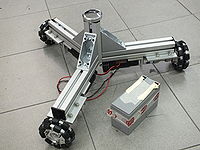Triskar2
Triskar2
| |
| Short Description: | Highly modular omnidirectional robot base |
| Coordinator: | AndreaBonarini (andrea.bonarini@polimi.it) |
| Tutor: | |
| Collaborator: | GiulioFontana (giulio.fontana@polimi.it), MartinoMigliavacca (migliavacca@elet.polimi.it) |
| Students: | |
| Research Area: | Robotics |
| Research Topic: | Robot development |
| Start: | 2012/10/01 |
| End: | 2015/12/31 |
| Status: | Active |
General features
Triskar2 is a highly modular, omnidirectional base, developed after some years of experience with omnidirectional robots Triskar developed for the Milan Robocup Team playing in the Robocup competition up to 2010.
Triskar2 is modular from the mechanical, the electronic, and the SW points of view.
Any mechanical dimension can be changed within hours. Each arm holding the motor is independent and can be locked on the central pillar in seconds. This also allows easy transportation. On the central pillar different "bodies" can be locked.
The electronics of Triskar2 is based on R2P, which allows easy and quick modifications.
Data processing is done onboard by a small-form-factor PC running software developed by AIRLab.
Triskar2 is currently under development as a base for some Robogames, the most advanced of which is presently Alien-Bot.
Components
Mechanics. The frame of the robot is based on Item mechanical elements Motor and transmission subsystems have been designed to minimize the number of mechanical elements that have to be especially built or customized for this application, thus reducing the time, tooling and skills required for modification, repair or construction.
Triskar2 uses three identical motor+transmission modules. Each of these includes the following elements:
- a Maxon motor+transmission+encoder combination (code #220251, composed of: #118798 DC motor mod. RE36, graphite brushes, 70W, ball bearings, 2 shafts; #166158 2-stage planetary gearhead, 2.25Nm, ball bearings; #110513 encoder, 500 impulses/turn);
- two Koyo model UP000 small pillow block bearings (many thanks to the Italian distributor MCI for helping us in getting these!);
- an omnidirectional wheel (model #14054, with hub #18009 for 10mm shaft) made by Opteq;
- a short wheel shaft (aluminium, 10mm diameter);
- an elastic joint (#0.0.628.83, made by Item).
The elastic joint is used to connect the transmission shaft to the wheel shaft, in order to reduce mechanical stress on the wheel/shaft connection.
Electronics. Electronic elements (e.g., motor control) of Triskar2 are based R2P, the modular robot architecture developed at AIRLab by Martino Migliavacca. Independent, low-cost, HW modules implement the single functionalities (motor control, communication, sensor interfaces, ...) and it is connected to the others via a CAN bus, participating in a publish-subscribe architecture supported by the real-time operating system ChiBiOS. This means that interaction among modules is implemented in real-time. Modules include an ST Microelectronics ARM processor on which the basic functionalities of the module are implemented. Therefore, any robot HW can be implemented in hours.
R2P exposes a [MicroROS] interface, enabling each R2P node to interact directly to any ROS node implemented on a connected computer or network.
Computing On the first instance of Triskar2 robot we mounted a small-form-factor PC by Zotac: model ID82, based on an Intel Core i3 2330M dual-core processor, fitted with 4GB of RAM. The PC is mounted on a quick-release tray.
Power Triskar2 uses a 24V DC power supply based on a couple of 12V sealed lead-acid batteries. The onboard PC requires 19V DC, which are generated by by a DCDC USB board by Mini-Box.

